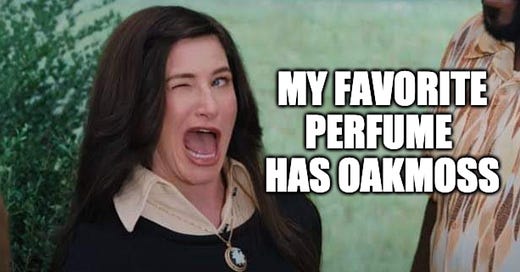Oakmoss is at the heart of some of the world’s well-known fragrances—at least it was until it was identified and labeled as an allergen. It was originally used in Chanel No. 5‚ among a host of other iconic perfumes of the 20th century. But the Chanel No. 5 manufactured today is not comprised of the same materials as the original. You’re literally smelling a different perfume.
Practically speaking, Chanel No. 5 is a dupe of Chanel No. 5.
How did we get here? This is a bewildering reality that leads to hilariously specific comment sections about moss, the green fuzzy stuff we never talk about, such as this comment left on Fragrantica.com:
“Now i am sitting here smelling my wrist and thinking about this whole vintage world before these regulations that limit natural oakmoss … If you are a true connosieur you have to smell this before you leave this earth.”
Things only get more complicated from here. No one is stopping you from loving your favorite perfume, but it may not include the things in it you think it does. A company can say a perfume includes a specific “note” (think “identifiable smell”) that is not … in it. Your jasmine perfume may contain no jasmine.
Ceci n'est pas une rose accord with a sandalwood base.
You know how grape candy has no grape in it? It’s like that, except grape candy costs 95 cents and a great perfume can set you back $150. For anyone with allergies, this is a great reminder that everything is always buyer beware. And the rules around how a material can be used (and where and why) are ever-changing to accommodate health and environmental impact research.
But there’s perhaps a more common yet less obvious reason why you may never “smell” something: you haven’t recognized it. For example, when I learned how to identify Linalool I discovered it was in every soap product I owned. Next time you’re in the shower, check out the ingredients on your bottles: it’s got a mild floral, spicy, woodsy scent. For me, it’s what makes soap smell like soap.
And then there’s the ever-relevant question of money (either yours or the cost of producing a fragrance with the source material). Last week, I mentioned there are secrets hidden in mossy woods and millionaire whale vomit hunters. Now you know the “secret”—but what about whale stuff? That’s collected as it washes up on shores, and is more like poop than vomit (got that mixed up!) and is so highly-sought out and difficult to “hunt” that it might be too expensive for you to afford to smell. True class warfare, and right on the nose. The best-case scenario here is that you are gifted a perfume with the whale poop known as ambergris.
Here’s a non-exhaustive shortlist of reasons why many scents are simply out of our nose’s reach:
The source material is limited, banned, or otherwise unavailable because of regulation (oakmoss);
The source material is extinct (dinosaur perfume?);
The source material is too expensive to ever find it used in products sold in the stores you shop in (ambergris);
The method of sourcing material is forgotten, lost, or otherwise unavailable for consumer use/access;
You’ve smelled it before and just don’t know (in my case, linalool);
Your nose cannot smell it :(
You may already know how Covid-19 can steal your sense of smell. It’s a devastating loss to our brain, which uses smell as a critical biological warning system, memory-maker, and hunger trigger, among other things. This time around, we discussed “forbidden” and/or lost scents—next edition, we’ll discuss why and how scent has a dramatic and underestimated impact on our lives.
I’ll leave you now with two things. First, consider that many people would prefer a fake to a real thing. Very existential stuff. Second, my whole-hearted recommendation for Nose, the new documentary about Dior master perfumer François Demachy.
If you like, write me back with your favorite perfume or materials, and I might share them in an upcoming edition.
Smell ya later,
Margarita



